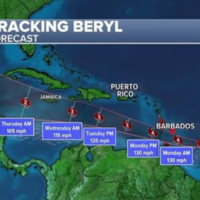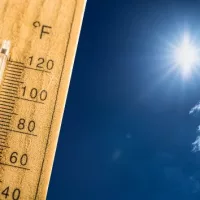
(BRIDGETOWN, Barbados) — Hurricane Beryl picked up power and speed on Sunday as it churned in the Caribbean and was upgraded to a major Category 4 storm, the first hurricane on record to reach major status east of the Lesser Antilles in the month of June.
The rapidly developing storm is now the earliest Category 4 hurricane in the Atlantic on record. Before Sunday, Hurricane Dennis, which became a Category 4 Atlantic storm on July 7, 2005, held the record.
On average, the first hurricane of the Atlantic season forms the second week of August. Beryl was the earliest Category 3 storm in the Atlantic since 1966.
A major hurricane is Category 3, 4 or 5, with winds of 111 mph or higher.
Beryl was a few hundred miles east of the Windward Islands on Sunday and was moving west over open waters.
By Monday morning, the hurricane’s eye is forecast to track just south of Barbados with 130 mph winds and produce 3 to 6 inches of rain across the region Sunday night and Monday. A storm surge of 6 to 9 feet is expected for Barbados.
From Barbados, the hurricane is expected to sweep across the Westward Islands with life-threatening conditions and head toward Jamaica, possibly reaching the island on Wednesday. The storm’s path on Sunday was shifting slightly south, and it’s too early to know if it will make direct landfall in Jamaica.
Right behind Beryl, there is another weather system that could become a tropical cyclone, as well, and may end up hitting Barbados on the same day Beryl is expected to bear down on Jamaica.
While it’s too soon to know with confidence, Beryl, or remnants of the storm, could reach southern Texas by next weekend, bringing heavy rain to the area. The alternative scenario is the storm remains wholly over Mexico.
In May, the National Oceanic and Atmospheric Administration issued its highest-on-record hurricane forecast for this Atlantic hurricane season. All categories of storms are expected to exceed the typical number seen every year, National Weather Service forecasters said at the time.
NOAA scientists predicted between 17 and 25 named storms this season, compared to an average of 14; between eight and 13 hurricanes, compared to an average of seven; and between four and seven major hurricanes, compared to an average of three.
Multiple officials, including National Hurricane Center Director Michael Brennan and National Weather Service Director Ken Graham, described the 2024 Hurricane Outlook as the “highest” forecast ever issued in May.
Climate change is likely having a significant impact on the Atlantic hurricane season, according to researchers.
Warming of the surface ocean temperatures from human-induced climate change is likely fueling more powerful tropical cyclones with more extreme precipitation, scientists say.
Copyright © 2024, ABC Audio. All rights reserved.















